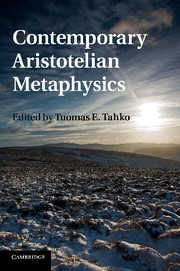Book contents
- Frontmatter
- Contents
- Contributors
- Preface
- Introduction
- Chapter 1 What is metaphysics?
- Chapter 2 In defence of Aristotelian metaphysics
- Chapter 3 Existence and quantification reconsidered
- Chapter 4 Identity, quantification, and number
- Chapter 5 Ontological categories
- Chapter 6 Are any kinds ontologically fundamental?
- Chapter 7 Are four categories two too many?
- Chapter 8 Four categories – and more
- Chapter 9 Neo-Aristotelianism and substance
- Chapter 10 Developmental potential
- Chapter 11 The origin of life and the definition of life
- Chapter 12 Essence, necessity, and explanation
- Chapter 13 No potency without actuality: the case of graph theory
- Chapter 14 A neo-Aristotelian substance ontology: neither relational nor constituent
- References
- Index
Chapter 11 - The origin of life and the definition of life
Published online by Cambridge University Press: 05 December 2011
- Frontmatter
- Contents
- Contributors
- Preface
- Introduction
- Chapter 1 What is metaphysics?
- Chapter 2 In defence of Aristotelian metaphysics
- Chapter 3 Existence and quantification reconsidered
- Chapter 4 Identity, quantification, and number
- Chapter 5 Ontological categories
- Chapter 6 Are any kinds ontologically fundamental?
- Chapter 7 Are four categories two too many?
- Chapter 8 Four categories – and more
- Chapter 9 Neo-Aristotelianism and substance
- Chapter 10 Developmental potential
- Chapter 11 The origin of life and the definition of life
- Chapter 12 Essence, necessity, and explanation
- Chapter 13 No potency without actuality: the case of graph theory
- Chapter 14 A neo-Aristotelian substance ontology: neither relational nor constituent
- References
- Index
Summary
Life’s origin, and the division between life and non-life
The physicist Paul Davies gives an excellent, eloquent account of the origin of life in his book The 5th Miracle (1999). Davies’s principal thesis is that although nothing rules out the possibility of life having originated on some other planet (e.g. Mars), the oldest forms of life on Earth consist of bacteria and other micro-organisms which eat unappetizing substances like sulphur and hydrogen sulphide and live in scalding volcanic jets four kilometres down at the bottom of the sea. These jets are known as ‘black smokers’ (Davies 1999: 166–86). Such organisms have probably existed on Earth for the last 3 or 4 billion years, and modern life-forms, which live in environments containing oxygen and derive energy directly or indirectly from sunlight, have literally ‘ascended from the depths’. Such an account flies in the face of more traditional origin-of-life Edens located on the surface of the Earth, or in atmospheres containing methane, hydrogen, and ammonia (Davies 1999: 86–7). But for heat-loving organisms living in rock crevices at the bottom of the sea, the Hades of a sulphurous thermal jet was doubtless heaven enough.
The problem Davies sets himself is to imagine conditions in the deep past which would have favoured, or at least permitted, the emergence of DNA and the manufacture of proteins by unicellular organisms. With DNA and protein-manufacture we have life: without them, merely physics and chemistry. Why is this? The reason is, according to Davies, that only with DNA and RNA do we arrive at the encoding of information, and the distinction between hardware and software, that separates living from non-living matter. DNA is built up out of long sequences composed of the four bases A (adenine), C (cytosine), G (guanine), and T (thymine). In the so-called genetic code a triplet composed of three bases, e.g. CGA or GTT, denotes a particular one of the twenty amino acids that go into the manufacture of proteins. Proteins consist of sequences of amino acids, and the information supplied by a DNA molecule enables cells to manufacture just the right proteins for the growth and development of the organism to which the DNA molecule belongs. Protein manufacture takes place in tiny mini-factories contained within the cell itself.
- Type
- Chapter
- Information
- Contemporary Aristotelian Metaphysics , pp. 174 - 186Publisher: Cambridge University PressPrint publication year: 2011



